Fritzie Sparks, my best friend’s mother, was fond of saying “Stress is the thing,” whenever the topic of illness came up in conversation. She’d tap the tips of her fingernails on the table or countertop to drive the point home. That was back in the ’70s, and it was just one of those things teenagers would find amusing about parents, but now that I’ve drifted into the older generation she once occupied, I can better appreciate her wisdom. In my teens the only things I recall being stressed about were acne and getting better grades than Mike Sharmin and Doug Shaffer, my high-school rivals. Now I have a long list of worries from an ongoing pandemic and pants growing ever tighter to meeting work deadlines and living in a 100-year-old house in an earthquake zone that’s bracing for the “big one.”For the past month, as the gloom of winter’s coming has darkened the skies of shortened days, I’ve chosen to take refuge not from the rain but in it. I’ll put on a couple of pile jackets, a knit hat, and my cagoule and sit in the back yard on a boat cushion set on an upside-down 5-gallon bucket—an orange one from Home Depot. The raindrops falling on my hood sound like salt sprinkled into a paper bag. With the sides of the canopy pulled up, I can row with enough shelter to keep my head and hands dry. Even though I have good rain gear, I feel less soggy with a roof over my head.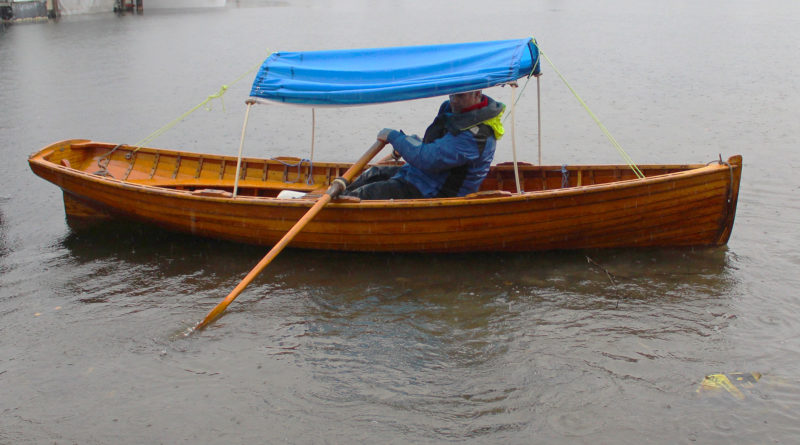
Join The Conversation
We welcome your comments about this article. If you’d like to include a photo or a video with your comment, please email the file or link.

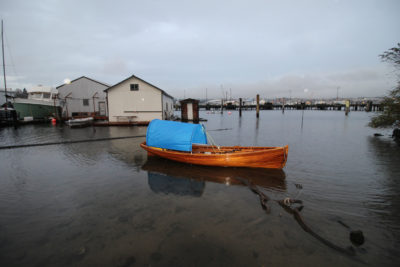
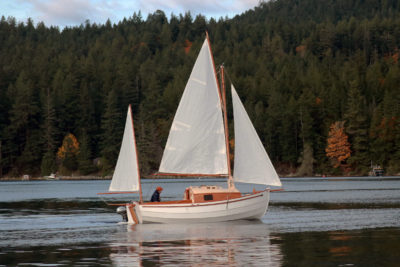
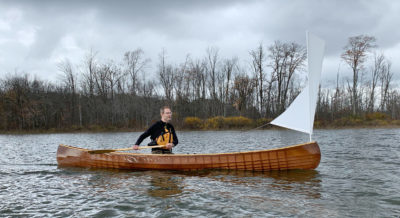
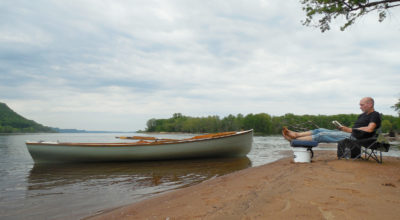
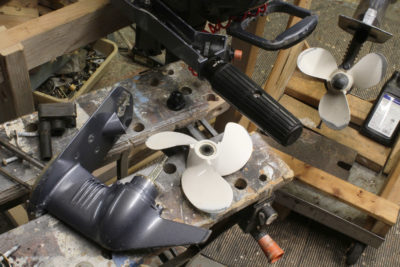
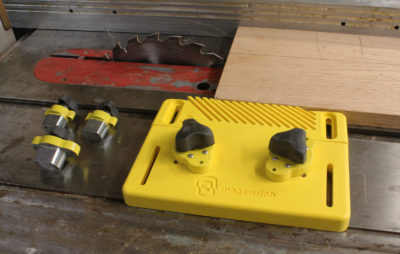
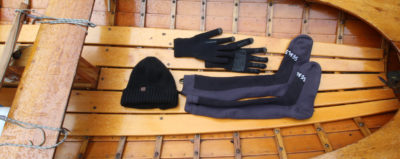
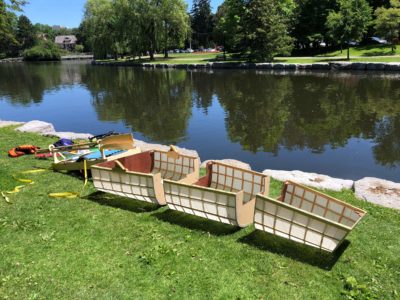

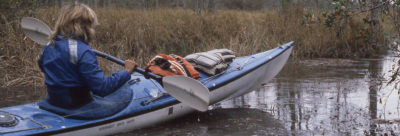
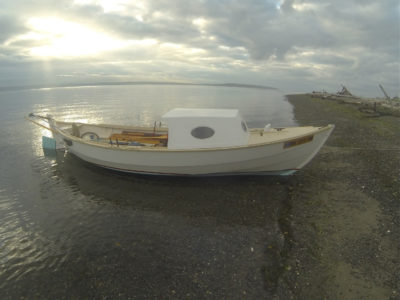
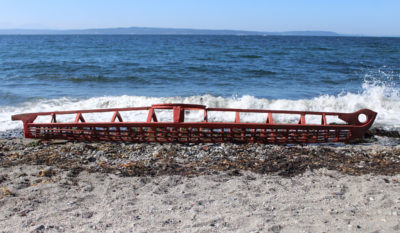
Chris,
I think your canopy is a very unique idea. Would it be possible to share your construction technique. The canopy could also be used to shade the rower or passenger on one of those scorching summer rows.
Scott,
Thanks for your interest. A fabric cover supported by hoops is an old idea. Jerome K. Jerome writes about a Thames skiff equipped with iron hoops and a canvas cover in Three Men in a Boat, published in 1889. The link will take you to the full text and you can do a search for “hoop” and the first mention will have a description and a drawing.
My system would indeed work well as a summer sunshade. I’ll add a description to the article shortly.
That’s a beautiful piece of watery meditation! Maharishi might not agree but your description sounds rather Zen-like rain-drop-mindfulness. Earth Shoes not needed here.
I have never experienced trascendental meditation, but in my very rare nights of sleeplessness, a playlist with rain sounds makes me sleep in seconds. Nothing beats that feeling.
Lovely
Chris,
Your canopy is ingenious, minimalist, functional – and you are most generous to share it. I have been riddling how to tame summer sun and rain when out in my CLC Expedition Wherry (it’s sort of a decked Whitehall) and you have solved the problem. Thank you.
David
Chris,
The article “Refuge in the Rain” brought back memories of paddling, racing, and guiding in Nebraska and Missouri. In some cases, it wasn’t only rain but also sleet and snow. Two that stand out the most:
I was guiding a group of eight fairly experienced paddlers along the Palisades on Grafton Lake north of Saint Louis. We were paddling on the south side of the river (the Missouri side). It was fall migration time and there was a flock of White Pelicans in nose to tail formation flying along the steep limestone cliff picking up thermal lifts just before a rain storm. Just guessing, I told the paddlers it was going to rain in minutes. I guided the group to beach near a picnic shelter along the shore. We needed to hurry up and wait out the rain in the dry. I nailed it—like clockwork it poured down rain with my clients and their boats undercover. We all had a nice dry snack watching the rain drops on river and the White Pelicans flying along the Palisades eventually out of sight up river.
To quote the NASCAR good old boys: Sometime the bear eats you, sometimes you eat the bear. That day the bear was extremely tasty.
It was just about time for Standing Bear Lake in Omaha to begin freezing over—mid December. We had one last paddle before the lake would eventually hard freeze and become very dangerous to kayak.
The early winter clouds were gray, fluffy, and sketchy cold. There wasn’t a lick of wind. A group of friends, all great paddlers, launched in the December day. It was dreadfully cold but all of us just had to get one last time on the water for the year. We were all properly dressed, had spray skirts, a wore either pogies or diver’s gloves. My wife, Chris, made the comment we all looked like kayaking polar bears.
We reached the middle of the lake as dark cloud drifted over us and began dumping a mixture of large white snowflakes and ice crystals. The world was shut out for about ten minutes. All we heard was the ice particles striking our decks and sizzle on the water. We all felt the snowflakes lightly touching our faces. There were no civilized noises. No sound of traffic. No visual shoreline. It was as though the lake didn’t exist. We all felt the impending winter firsthand. This was only a small taste of what was to come.
Eventually the snow cloud drifted on to the south and the sun began piercing the gray wintertime clouds. For a couple of moments, the brilliance blinded us. We drifted back into the world of traffic noise, the shoreline, and the end of our paddle until next spring when the ice and snow disappear.
I like that idea except I might try it in a “plasticpane” version on outside. It’s a see-through plastic like on marine side curtains. HH-66 glue works good instead of sewing.
Chris, “Thank You!” for the article. I am just finishing up a stem-to-stern refit of my 17′, copper-riveted lapstrake, Whitehall. I’ve been toying with various canopy ideas, but yours seems to be what I was looking for all along! Thanks again, and maybe we’ll cross wakes out there on the water someday.
Cheers!
Mark in Port Townsend
Just messing around in boats is the most joyful thing. I can’t wait to do something similar when I finish my Acorn 12′ rowboat, I will also rig it for sail. I love small boats, but I also have a Catalina 22. Spring can’t come fast enough!
Seeing your very well thought out canopy was particularly interesting as I am considering making a hard-sided version in 3mm marine plywood with top-hinged sides.
There’s something really lovely about being sheltered from rain, even whilst wearing fully waterproof gear.
Your canopy is really practical and the photograph of you happily reclined after tea and banana cake as the rain danced rhythmically on the canopy emphasised the benefit better than words ever could.
Budget Biminis — I love this. Thanks so much for posting Chris. Now I can’t wait to bliss out to the sound of the rain!